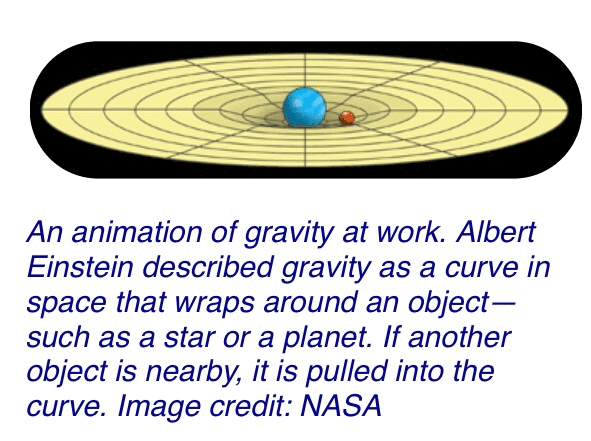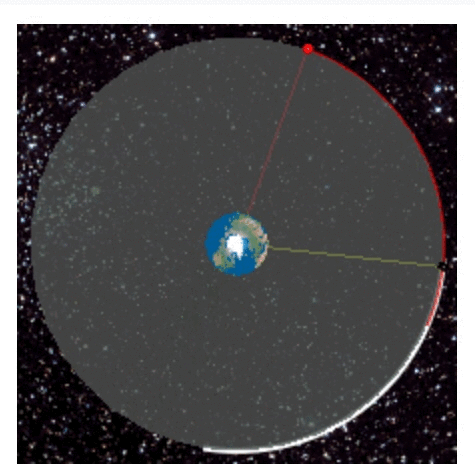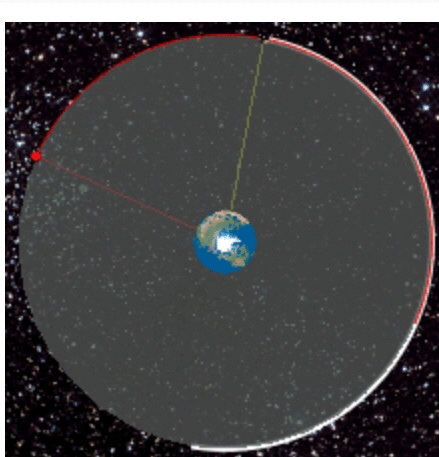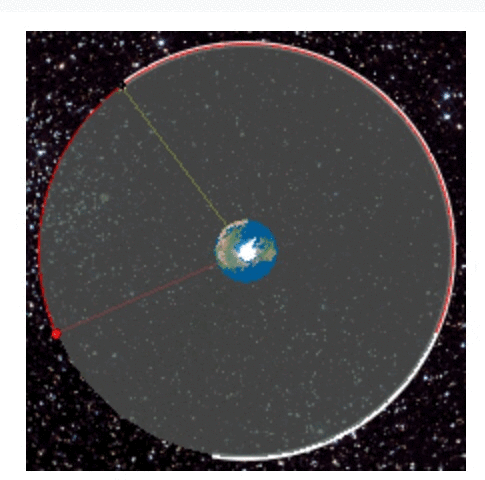It looks like you're using an Ad Blocker.
Please white-list or disable AboveTopSecret.com in your ad-blocking tool.
Thank you.
Some features of ATS will be disabled while you continue to use an ad-blocker.
share:
a reply to: InfiniteTrinity
The direction of gravity does not change. It is always directed towards Earth's center of mass.
No Phage it does not. It would have to move around the curvature to experience a change in the direction of gravity
The direction of gravity does not change. It is always directed towards Earth's center of mass.
I know you did. You are, again, incorrect.
But I said this
edit on 8/17/2019 by Phage because: (no reason given)
a reply to: neutronflux
Why do you keep mentioning geosynchronous orbits?
We are discussing geo stationary.
How clear can it be. The one object has to move around the other in order to orbit it.
Told you 60 times now. Unbelievable.
Then clearly state what your argument is concerning why a geostationary/ geosynchronous is not in earth orbit.
Why do you keep mentioning geosynchronous orbits?
We are discussing geo stationary.
How clear can it be. The one object has to move around the other in order to orbit it.
Told you 60 times now. Unbelievable.
a reply to: Phage
Wow the confusion.
Then tell me Phage, How does it maintain a curved trajectory through space if it is not falling around a curve of the direction of gravity?
Game over Phage.
Phage, why dont satellites fall back to Earth?
The direction of gravity does not change
Wow the confusion.
Then tell me Phage, How does it maintain a curved trajectory through space if it is not falling around a curve of the direction of gravity?
Game over Phage.
Phage, why dont satellites fall back to Earth?
edit on 17-8-2019 by InfiniteTrinity because: (no reason given)
a reply to: InfiniteTrinity
I told you how. The curve is due to the combination of acceleration due to gravity and the velocity of the satellite.
How does it maintain a curved trajectory through space if it is not falling around a curve in the direction of gravity?
originally posted by: InfiniteTrinity
a reply to: Phage
I know you did. You are, again, incorrect.
Then what is the correct frame of reference Phage?
Why are you being so hesitant Phage?
Frame of reference for angular momentum? That would be the satellite,I suppose, since it is the satellite which possesses the momentum.
I'm not hesitant.
a reply to: InfiniteTrinity
Only if the vector of the satellite's velocity were parallel to that of acceleration due to gravity. I said that.
www.abovetopsecret.com...
That would be the acceleration straight down to the surface Phage.
Only if the vector of the satellite's velocity were parallel to that of acceleration due to gravity. I said that.
www.abovetopsecret.com...
edit on 8/17/2019 by Phage because: (no reason given)
originally posted by: InfiniteTrinity
a reply to: neutronflux
Then clearly state what your argument is concerning why a geostationary/ geosynchronous is not in earth orbit.
Why do you keep mentioning geosynchronous orbits?
We are discussing geo stationary.
How clear can it be. The one object has to move around the other in order to orbit it.
Told you 60 times now. Unbelievable.
Again...
From the earth’s surface. A geostationary satellite appears to be “fixed”. But that same satellite is traveling the “curve” of earth’s gravity well. Orbiting around the center of earth’s gravity well. If you use the earth’s axis as a fix point of origin, you can solve for the angular momentum of a geostationary / geosynchronous satellite.
You
You guys are hilarious. You keep posting the same dumb contradiction I debunked about 40 times now.
The only thing dumb is that you cannot realize the earth’s rotation has nothing to do with earth’s gravity well. And it’s ”dumb” that you think a satellite cannot be in orbit because it is at a height and speed that matches the earth’s rotation.
First off, the earth’s rotation has nothing to do with the ability of a satellite to orbit. In reality, a satellite does not orbit the center of the earth. A satellite orbits the center of Earth’s gravity well. An orbiting satellite could careless if the earth was rotating, and at what speed.
What is gravity?
spaceplace.nasa.gov...
Second: Why can you not get through your head a geostationary/ geosynchronous still obits the earth. It’s just at a speed that keeps it above a specific point and n earth. But a geostationary / geosynchronous satellite is still traveling around earth’s gravity well.
Geostationary orbit
en.m.wikipedia.org...
A geostationary orbit, often referred to as a geosynchronous equatorial orbit[1] (GEO), is a circular geosynchronous orbit 35,786 km (22,236 mi) above Earth's equator and following the direction of Earth's rotation. An object in such an orbit appears motionless, at a fixed position in the sky, to ground observers. Communications satellites and weather satellites are often placed in geostationary orbits, so that the satellite antennas (located on Earth) that communicate with them do not have to rotate to track them, but can be pointed permanently at the position in the sky where the satellites are located. Using this characteristic, ocean-color monitoring satellites with visible and near-infrared light sensors (e.g. GOCI) can also be operated in geostationary orbit in order to monitor sensitive changes of ocean environments.
a reply to: InfiniteTrinity
Incorrect.
If you are in a car moving at 20 mph and a car next to you is moving at 20 mph, does that mean the car next to you has no momentum?
The only correct frame of reference is the object Earth.
Incorrect.
If you are in a car moving at 20 mph and a car next to you is moving at 20 mph, does that mean the car next to you has no momentum?
a reply to: Phage
No it means the angular momentum in the irrelevant frame of reference, is irrelevant, Phage.
If you are in a car moving at 20 mph and a car next to you is moving at 20 mph, does that mean the car next to you has no momentum?
No it means the angular momentum in the irrelevant frame of reference, is irrelevant, Phage.
edit on 17-8-2019 by InfiniteTrinity because: (no
reason given)
originally posted by: InfiniteTrinity
a reply to: Phage
If you are in a car moving at 20 mph and a car next to you is moving at 20 mph, does that mean the car next to you has no momentum?
No it means the velocity in the irrelevant frame of reference, is irrelevant, Phage.
That’s all you got? When you been schooled again?
Hahahahahahahahaha
originally posted by: InfiniteTrinity
a reply to: Phage
Where is gravity accelerating it to?
Probably the same point when you jump off the ground with the same speed of earth’s rotation.
edit on 17-8-2019 by neutronflux because:
Added and fixed
edit on 17-8-2019 by neutronflux because: Added and fixed
a reply to: neutronflux
So straight down then?
How does it maintain its speed to maintain the curved trajectory through space then?
Go ahead.
So straight down then?
How does it maintain its speed to maintain the curved trajectory through space then?
Go ahead.
edit on 17-8-2019 by InfiniteTrinity because: (no reason given)
a reply to: InfiniteTrinity
Fine. Tell that to the other car when it hits the car in front of it.
No it means the angular momentum in the irrelevant frame of reference, is irrelevant, Phage.
Toward Earth's center, but that acceleration is counteracted by the satellite's momentum, the result is an orbit.
Where is gravity accelerating it to?
new topics
-
Resident Plane enthusiasts needed weird noise
General Chit Chat: 2 hours ago -
Fired FEMA Employee Says It Was Not ‘Isolated’ Incident: ‘Colossal Event Of Avoidance’
US Political Madness: 5 hours ago -
Australia has been holding out on us
Music: 5 hours ago
top topics
-
Fired FEMA Employee Says It Was Not ‘Isolated’ Incident: ‘Colossal Event Of Avoidance’
US Political Madness: 5 hours ago, 21 flags -
DEI is getting pummled
Other Current Events: 15 hours ago, 16 flags -
Australia has been holding out on us
Music: 5 hours ago, 3 flags -
Resident Plane enthusiasts needed weird noise
General Chit Chat: 2 hours ago, 3 flags
active topics
-
Australia has been holding out on us
Music • 3 • : gort69 -
60s-70s Psychedelia
Music • 44 • : BasicResearchMethods -
Resident Plane enthusiasts needed weird noise
General Chit Chat • 6 • : Flyingclaydisk -
Should we look for the truth, or just let it go?
US Political Madness • 89 • : NorthOS -
The Great Reckoning
Rant • 51 • : BrucellaOrchitis -
Russia Ukraine Update Thread - part 3
World War Three • 6764 • : Oldcarpy2 -
The Trump effect 6 days after 2024 election
2024 Elections • 60 • : cherokeetroy -
Thousands of Protesters March in NYC -- ‘Donald Trump Has Got To Go’
Social Issues and Civil Unrest • 103 • : Xtrozero -
Waterloo in 20mm world's largest diorama (on view at NAM Chelsea Oct 20 & 21) new pics added 10 -16
Member Art • 45 • : BrucellaOrchitis -
Fired FEMA Employee Says It Was Not ‘Isolated’ Incident: ‘Colossal Event Of Avoidance’
US Political Madness • 26 • : xuenchen





